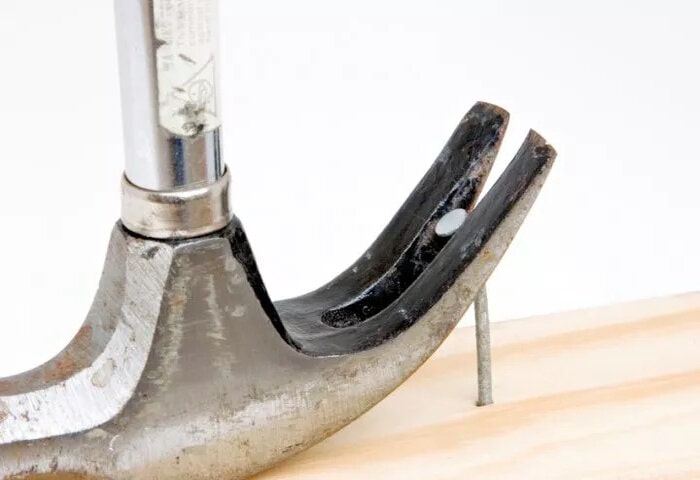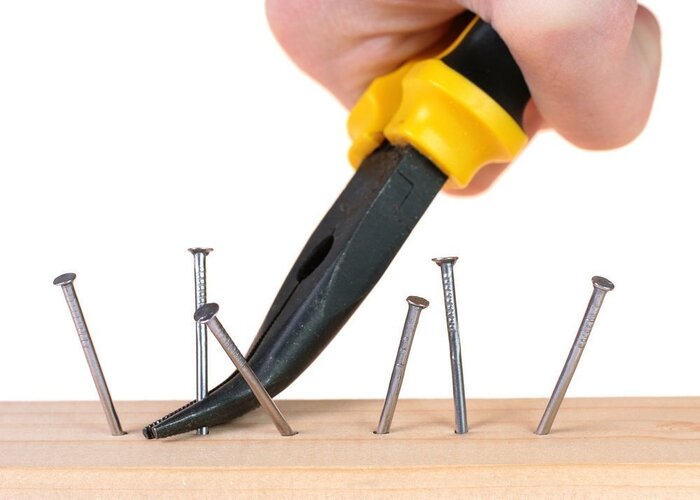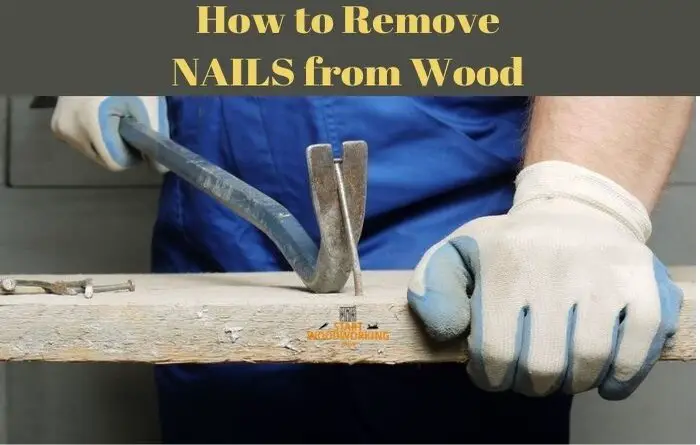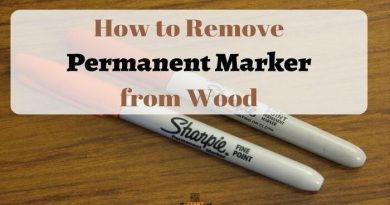How to Remove Nails from Wood [The Quickest & Easiest Way]
In woodworking, there is a need to remove nails from wood. So it is worth knowing how to remove nails from wood that we will be explained in detail in this post.
How to Remove Nails from Wood Step by Step
Step 1
To do this, we can use a simple hammer. We insert the head of the nail into the slit at the back of the tool and, making the smooth part, exert force upwards and to the side, until the tip is removed.
Step 2
Another simple and equally effective alternative is to extract the nail using pliers. Once attached, we pry by leaning on the rounded surface of the tool. We carry out this step as many times as we need to remove the nail.
Step 3
We can also opt for a lever that, having the longer handle, allows us to move the force point to a further area, having to apply less pressure.
Step 4
When the surface on which we are going to work is quite delicate, before using any of the below mentioned tools , it is advisable to place a protector to avoid damaging it.
With what tools can you remove nails from wood?
You can use multiple tools to remove nails from wood like:
- Hammer
- Pliers
- Crowbar
- Thin wedge
- Side cutters
- Scissors
- Another nail
- Lever
Now we will explain in an easy step by step guide how you can use each of these tools to remove nails from wood!
How to Remove Nails from Wood
1. Hammer. Many of the types of hammers that exist today have a sharpener on the opposite side of the head. It is really practical when the head of the nail is still not inserted and we appreciate that we are inserting the tip in the wrong way or in the wrong place. You only have to pass this head through the slot and, once it is embedded in the tool and resting on the board, pry until its complete removal.
2. Pliers. A pair of pliers will be better to remove the nail completely if it has already been inserted all the way, or to make the head of the nail stick out. Put light pressure on the board as you close the tool over the nail head. Once you have this clamp, place a small wooden block or the metal wedge of a hammer next to the pliers and pry on this block so as not to damage the original surface.
3. Crowbar. A crowbar or handle of the appropriate size is another option that will facilitate the task. To do this, use the same technique as with the hammer .
4. Thin wedge. If you don’t have any of these tools at home, don’t worry. Try driving a thin, metal wedge, such as a blunt knife or spatula , by tapping it toward the nail. Once the homemade tool is placed under the head, it will have protruded a minimum. Use the blades of scissors to extract them little by little. Remember that you must do it with the point closest to the crosshead of the scissors blades and little by little or they can split.
5. Side cutters. If the nail you need to extract does not have a head, you can do it with side cutters if any part of it is exposed . If not, you can remove it from the other side of the board, driving a second nail over the first.
6. Scissors. To do this, push the slightly opened scissors under the nail head as far as it will go and gently press the scissors together. Now you can try to pry the nail out with the scissors. But be careful: when you move the lever, the tips of the scissors can dig into the wall or the wood and damage the surface. Again, this can be avoided by placing a flat piece of wood or sturdy cardboard underneath. Or you can grab the scissors at both ends and pull the nail straight out.
How to remove nails with Hammer

Once you have a firm grip on the nail, you will need to use the claw end of your hammer to pull the nail out.
Be careful when you pull the nail out of the wood. You can loosen it by moving it back and forth with the pliers. Position the hammer so that the claw is between the tongs and the wood surface.
How to remove nails with Pliers

For simpler cases, pliers with round tips are used. Grab the nail with the tool just below the nail head and loosen it with twisting and lever movements.
The following rule of thumb applies: the longer the pliers, the stronger the leverage. If the nail head sits very close to the wall, do-it-yourselfers should use a nail iron.
To avoid pressure points, it is best to place a cloth between the wall and the iron. If the nail is very tight, apply a drop of oil.
How to remove nails from wood with Screwdriver
Nails are often hammered into the wood or the floor of the floorboards in such a way that the nail head hardly protrudes and is therefore difficult to grip with pliers, a nail iron or a lathing hammer.
Instead, you can carefully slide a flat-bladed screwdriver under the nail head and use light lever movements to push it out.
As soon as it is far enough out, the pliers can be used. If you don’t have it at hand, you can use a fork.
Simply clamp the nail head between two prongs and remove the culprit with a little pressure upwards.
How to remove nails from wood using a different nail
In order to remove a nail from wood using another nail you need to go from the opposite part of the nail.
- First insert another nail for example a box nail.
- Hammer the other nail through the wood surface.
- You need to clearly hit the center of the stuck nail.
- Hammer it until you can see the stuck nail head, then use the plier to remove it.
This methods is good only for nails that sticks out of the opposite end of the wood surface.
Do you know what rubber wood is? I bet you didn’t know that is the best wood you can find!
How to remove a nail from wood with a Pry Bar
If nails are very rusty, pulling them is like a feat of strength. In this case, do-it-yourselfers should never use force.
Because this can break the nails. If the nail still has a head, a pry bar is the best. Before this is placed on the wood, slide a piece of hardwood in between as a buffer.
This way, marks can be avoided. Then slide the tips of the pry bar around the nail and then carefully pry it out.
Alternatively, a nail iron is also suitable. If the nail head has broken off, use pliers.
How to Remove Headless Nails from Wood
The first method to remove a headless nail or brad nail from wood is to use side cutters pliers. To not damage the wood surface use a wooden support between the pliers and the nail.
- Try to firmly grip the nail
- Press the handles of the side cutter pliers and hold the brad nail tightly
- Start to slowly swing the nail from side to side in order to remove it.
The second method to remove a stuck headless nail is by heating.
- Heat the nail and the wood surface around it with a gas burner
- Because of the heat the metal will expand and then shrink so the surface will became weaker. Also the wood surface around the nail will dry up.
- This will allow you to remove the nail using the same pliers mentioned above.
The third method is to take a piece of metal tube or pipe.
This pipe will need to have the diameter larger than the nail diameter with one end serrated and the other one inserted into a drilling machine.
Start to drill out the nail by placing the serrated pipe in the center. This will allow you to quickly remove the nail. The only problem is that a hole will remain in the wood which can be closed after with a plug.
4 Alternative Methods How to Remove Nails from Wood
1.Using Scissors
To do this, push the slightly opened scissors under the nail head as far as it will go and gently press the scissors together.
Now you can try to pry the nail out of the wood with the scissors. But be careful: when you move the lever, the tips of the scissors can dig into the wall or the wood and damage the surface.
Again, this can be avoided by placing a flat piece of wood or sturdy cardboard underneath. Or you can grab the scissors at both ends and pull the nail straight out.
2.Using Heat
Another trick is to apply a heat source to the brad nail without damaging the wood where it is embedded.
With a lighter, heat the area. You will have to do it very carefully. When the screw or nail is hot, you can get rid of it very easily.
3.Using a lever
The hammer or a crowbar provides the leverage. However, whatever tool you use will put pressure on the wood surface at a point that can cause damage.
To protect the wood surface, you can use a small piece of wood as a buffer.
Make sure to sand the wood well before removing the nail as rough edges can damage the finish of wood you are pulling the nail from.
4. Using bubbly cola.
The first thing you will need is a cola with bubbles.
Soak the nail both the metal part and the area where the metal meets the wood in which it is embedded.
Let it act for a few minutes, after this time you can remove it easily.
How to Remove Rusty Nails from Wood
If nails are very rusty, removing them from wood is like a feat of strength. In this case, do-it-yourselfers should never use force because this can break the nails.
If the nail still has a head, a roofing hammer is best . Before this is placed on the wood, slide a piece of hardwood in between as a buffer.
This way, marks can be avoided. Then slide the tips of the roofing hammer around the nail and then carefully pry it out.
Alternatively, a nail iron is also suitable. If the nail head has broken off, use pliers.
Rusted nails can be removed from wood more easily if you first treat them with a rust remover or WD-40.
An alternative is heating with a soldering iron with a wide tip – the heat scorches the fine structures of the teeth so that nails can be removed more easily.
Other methods include cutting off the head with a hacksaw, angle grinder or Dremel and, in an emergency, using a center punch to drive the nail through the wood, with or without a head.
How to remove nails without damaging wood?
In order not to damage the wood surface, you can put a piece of tin can underneath or wooden support between the pliers and the nail.
In order to fix the head of the nail, place it on a wooden support and hold the nail firmly, so as not to damage the work surface and not hurt your fingers with the pressure exerted during the blows.
To drive very small nails, difficult to hold in your hand, you can help yourself with a specially shaped cardboard strip.
The pincer with extended arms is much more suitable for extracting nails: the arms have in fact a better lever effect. Using a support is recommended to avoid damage to the surface of the piece.
Conclusion
The methods presented above are the most common ones to help you remove nails from wood. Even if you don’t have the proper tools for this task the tips and tricks presented above will help you complete the task.
Following the methods that we have given you, you can remove nails from the wood, without problems.




